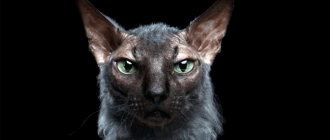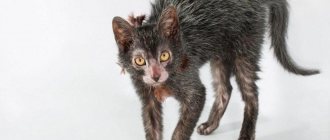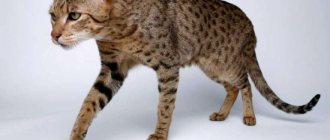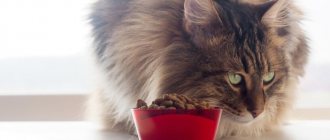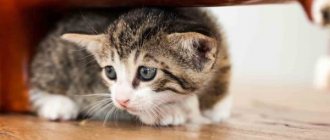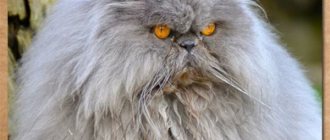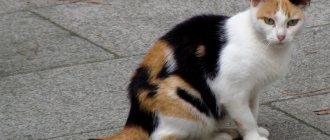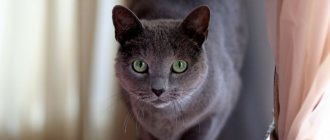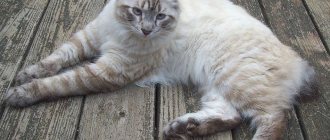| Origin | USA |
| Wool | short |
| Dimensions | 3.5-4.5 kg |
| Lifespan | 15 years |
Likoi is an amazing cat with an extraordinary appearance. Large eyes and unruly fur sticking out in all directions make one think that the animal has some kind of demonic origin. Therefore, many people compare a cat with a werewolf or a creature from a parallel universe, attributing otherworldly abilities to it. But the Likoi, despite its appearance, is an affectionate, devoted pet.
Brief history of the breed
Lykoi cats were bred in 2010 in the US state of Virginia. The history of the breed began with the fact that an ordinary short-haired female gave birth to babies with partially missing fur. The owner of the kittens, Patti Thomas, saw in the peculiar appearance of the newborns a resemblance to characters from horror films and began to call them Lykoi.
To understand the heredity of the unusual offspring, the American woman turned to the breeder of Canadian Sphynx dogs, John Gobble, for advice. He studied the issue in detail and found out that two similar kittens were born in Tennessee. This information gave hope for the emergence of a new exotic breed.
Genetic studies have shown that all four kittens have the same recessive gene in which a mutation has occurred. Breeders managed to very quickly consolidate the characteristics characteristic of Lykoi. And as a result of a special program, in which both pairs of the first cats participated, in the fall of 2011, kittens of the second generation were born with the same characteristic appearance. In 2012, the breed was recognized by American and some world felinological organizations.
Interesting facts about werecats
Despite the fact that the Lykoi have a short history, a lot of interesting things have happened to them:
- The name of this cat breed comes from the Greek word lykoi, translated meaning “werewolves” or “werewolves”.
- Due to their unusual appearance, which gives these pets a resemblance to fantastic creatures, representatives of the breed are often called werewolves, Licon cats or devil cats.
- Before Lykoi were bred, their characteristic color was found only in horses.
- Genetic tests have shown that representatives of the breed do not have the gene for hairlessness, which is characteristic of representatives of hairless cat varieties. Based on this, it was concluded that the Lykoi are not related to the Sphinxes and Devons.
Peculiarities
Several names for the breed were proposed, but the choice fell on “Likoy,” a word from Greek translated as “werewolf” and meaning a mythical creature that is reborn into a wolf. However, representatives of the breed did not arise in a mystical way, but through natural mutation and do not at all possess the features of a monster.
Lykoi has no genetic similarity to the Sphynx and Devon Rex. This fact is confirmed by the results of DNA tests carried out repeatedly.
The folded skin of the breed is very sensitive to high temperatures. Just a few hours in the sun and dark pigment spots appear on the skin, and exposure to sunlight for several days leads to a complete tan, with the skin becoming pitch black. The same effect is produced by exposure to heat, for example, if a cat sleeps on a radiator. But a few weeks without direct exposure to the sun and heat, and the skin takes on a natural pink color.
Description of the breed standards, appearance of the Lykoi
Lykoi are harmoniously built, thin-legged cats with expressive eyes and uneven coat. A breed standard with a detailed description of these animals was developed in 2012.
Dimensions and weight
Lykoy cats are not heavyweight breeds. The average weight of an adult female is 3.5 kg. The weight of a male can reach 4.5 kg.
Anatomical characteristics
According to the TICA standard, Lykoi cats must meet the following description:
- The head is medium in size, wedge-shaped, with soft contours, a slightly elongated forehead, a bald muzzle and fleshy, smoothly outlined whisker pads. The cat's nose is rounded and slightly pointed downwards.
- The eyes are large, slanted, with an open, penetrating gaze. A cat's iris is yellow, green or blue-gray.
- The ears are large, set far apart, with a wide base and pointed tips.
- The body is flexible, slightly elongated, thin, with well-developed muscles.
- The limbs are thin, of medium length, with oval paws and a bare lower part.
- The tail is short, gradually tapering towards the tip.
We recommend the article – “Top Most Scary Cats“.
Color and coat type
Lykoi are covered with soft, loose fur that grows in tufts, the thickness of which depends on the time of year. Due to the lack of down and a very thinned spine, it seems that cats of this breed suffer from a dermatological disease. And the bald patches on the face form a kind of mask.
The coat color of cats of this breed in professional terminology is referred to as roan. Each hair has a light gray or white base and a black tip.
On a note. Lykoi kittens are born with black fur. The graying characteristic of the breed appears on their coats as they grow older.
Possible breed defects
Disadvantages, in the presence of which a wolf cat will not receive a high rating for its exterior:
- limbs completely covered with fur;
- absence of a bald mask on the face;
- all color options except roan.
Lykoi kittens
Externally, kittens are almost no different from adults. They look ragged and awkward with prominent large ears. Kittens are born with a variety of coat colors, but only those with solid black roan coats are accepted for exhibition.
It is noteworthy that kittens are born with solid black fur. But after the first molt, at two to four weeks of age, new white and black hairs grow. The color is called “roan” and is found in dogs and horses. DNA analysis showed that the pattern is not tabby.
From birth, kittens have no hair around the eyes, chin, nose and outer top of the ears. The ears and nose are leathery to the touch. The legs of most individuals are covered with sparse hair.
Mature males can be significantly larger than females.
Character and temperament of a werecat
Lykoi are endowed with a good-natured, flexible and sociable disposition. Cats of this breed quickly become attached to their owners, but are wary of strangers. Lykois have no problem remaining alone and do not become stressed from a long separation from their owner.
On a note. The specific nature of cats of this breed does not allow them to easily make contact with strangers. And if the Lykoi suspect a stranger of bad intentions, they will attack without hesitation.
Lykoy cats get along well with their relatives and with non-aggressive dogs. True, sometimes conflicts can arise between them. Due to their developed hunting instinct, Lykoi will not tolerate small rodents or birds near them. Therefore, having a hamster or parrot as a companion for a werecat is not the best idea.
Personality of Likoy cats
Lykois are very attached to family members, making them considered ideal family pets. But only if they are taken care of and given attention. With those whom the cat trusts, she is affectionate and playful.
Animals prefer to spend more time with people, but if they happen to be left alone, cats find activities for themselves, for example, they enthusiastically play with toys or any other objects in the room. There is no need to be bored if there are several cats or a dog in the house.
Likoy reacts to strangers in the house with restraint and caution, anticipating potential danger. If there is a threat to itself, the cat may attack or bite, which is especially true for curious or aggressive dogs. But some time after meeting, having ruled out a threat to himself, the stranger will receive a friendly attitude from the cat.
Lykoi can make a person feel uneasy with just a glance. Sometimes it seems that cats look through a person with open yellow eyes, they are able to read thoughts, their gaze is so soulful.
Smart cats show intelligence when solving problems that arise during the game. They do an excellent job with intellectual toys, finding ways to achieve a goal, for example, getting a parrot out of a cage.
In terms of temperament, Lykoi are compared to hound breeds of dogs, endowed with an excellent sense of smell and distinguished by a developed hunting instinct. If there are other pets living in the house, for example, a parrot, a hamster, then they can become prey for Lykoi. The cat will bring its prey to its owner’s feet without the slightest embarrassment. Lykoi love to hunt and do it excellently. Toys and the owner's legs can become objects of hunting. The prey instinct manifests itself most strongly during the game.
How to choose the right kitten
Lykoi is a cat of a rare and small breed, so it is not so easy to buy one. There are only a few nurseries registered with TICA that specialize in breeding these animals, and all of them are located in the United States.
This means that you will have to negotiate with breeders to purchase a kitten resembling a werewolf over the phone, and choose your future pet in absentia.
Before you finally decide and conclude a deal, it is advisable to pay attention to the following nuances:
- availability of documents;
- compliance with breed standards;
- conditions of detention;
- behavioral characteristics;
- health status.
On a note. Little Lykoi differ from kittens of other breeds by the presence of a bald mask on the face and hairless areas on the paws.
Kitten care
Little Lykoi go to new homes no earlier than 12 weeks of age. At this point, kittens that look like a werewolf are already accustomed to solid food, a tray and a scratching post, and also have routine vaccinations. To make Lykoys feel comfortable with their new owners, they are given a cozy bed, bought several toys and given a few days to adapt.
To prevent the inquisitive werewolf cat from being injured, his access to electrical wires, detergents, ornamental plants, small objects, large household appliances, open balconies and windows is blocked.
Care and maintenance of werecats
Lykoi are unpretentious pets; they do not require special conditions. True, due to the partially absent coat, representatives of the breed must be protected from direct contact with ultraviolet radiation, because under the influence of sunlight, their bare skin temporarily becomes covered with dark spots or completely blackens. Otherwise, cat care comes down to simple hygienic procedures.
Hygiene procedures
In order for a cat with the appearance of a werewolf to have a neat appearance, she is provided with appropriate care:
- Lykoya's claws are shortened with a nail clipper as they grow. Moreover, only the transparent ends are cut off. To prevent a werewolf in cat skin from scratching the furniture upholstery, he is provided with a scratching post.
- Twice a week, Lykoyas brush their teeth with a soft brush and non-foaming paste. To prevent plaque and tartar, the werecat is offered special chewable treats.
- The ears and eyes of the Lykoi are regularly inspected for the presence of uncharacteristic discharge and gently wiped with cotton pads soaked in alcohol-free lotion or herbal decoction.
Grooming
Lykoi are partially hairless pets with hairless areas on their bodies. Hairless skin of cats sweats, so it is regularly wiped with wet wipes.
Shedding in representatives of this breed does not depend on the season, so they can change their coat several times throughout the year. To make a cat's ragged coat look well-groomed, it is brushed several times a week with a special brush. During the period of active molting, the procedure is carried out daily.
Tray
The cat of this breed is very clean and quickly gets used to relieving itself in a designated place. Until the little Likoi grows up, he is provided with a tray with low sides. And for adult cats, they buy a litter box whose dimensions correspond to their size. It is advisable to use wood or mineral granules as a filler for the Lykoya tray.
Maintenance and care
Unlike other breeds, the Lykoi needs more frequent bathing, because a coating of sweat forms on the bare areas of the body. Bathing can be replaced by cleansing the skin with wet wipes. By the way, cats of this breed have a negative attitude towards water.
Clean the ears once a week and regularly monitor the condition of the eyes. It should be noted that the claws of representatives of the breed grow quickly. They also need weekly care.
Lykoi shed intensively, all hair may fall out during the molting period. Over the course of a year, animals grow new hair, which is darker or lighter than the old one and can cover the entire body.
Feeding the werecat
Due to increased heat exchange, Lykois should receive larger portions than cats of other breeds. It is important to maintain a balance so as not to overfeed your pet.
Complete diet
Professionals recommend giving lykoia high-quality premium or super-premium drying. When choosing food for representatives of the breed, it is advisable to pay attention to expiration dates and composition. It is important that the feed does not contain soy, corn, wheat and other unhealthy additives. The following brands of drying best fit these criteria:
- Royal Canin;
- Hills;
- Acana.
With a natural type of feeding, Lykoi should receive a sufficient amount of raw lean meat, ocean fish and offal. Also, the diet of werecats can be diversified with quail eggs, cereals, boiled vegetables and sour milk.
To maintain health, Lykoys are never given sausages, pickles, smoked meats, mushrooms, potatoes, pork, river fish, sweets, pastries or any food from the host’s plate.
Feeding frequency
The number of meals depends on the age of the werecat:
- up to 4 months – 6 times a day;
- 4-5 months – 5 times a day;
- 5-9 months – 4 times a day;
- 9-12 months – 3 times a day.
From the age of one year, Lykoi can get by with two feedings a day.
Vitamins and minerals
To prevent Lykoi from suffering from vitamin deficiency, special supplements are introduced into their diet twice a year. It is important that the selection of vitamin and mineral complexes occurs with the participation of a veterinarian familiar with the characteristics of a particular cat.
Description and standard
Despite the fact that the Likoy breed is young, there are already clear standards for the animal’s appearance and its main characteristics.
- General form. Medium sized animal. Males grow up to 4.5 kg, females - up to 3.5. The build and size are similar to sphinxes. The skeleton is small, the muscle structure is pronounced, the face is lean and elongated. The chest is expanded, the back rises in the shape of an arc.
- Limbs, tail of medium size. Legs bare or with little hair. The tail is comparable to a rat's due to the lack of hair.
- The head is medium in size, the muzzle is wedge-shaped. The nose is wide with a straight transition to the forehead.
- The cat's ears are large, triangular in shape, stand straight, and slightly rounded.
- The eyes are like walnuts. The color can be varied - gray, golden, emerald, gray with blue, ash blue, copper yellow. There is no fur around the eyes.
Raising and physical activity of a werecat
Lykoi are energetic cats with strong hunting instincts. Representatives of this breed love to walk on a leash and have fun with improvised toys.
To maintain good physical shape, the lykoyam is equipped with a corner with tunnels, ladders and multi-level platforms. And so that werecats have something to do in the absence of their owners, they buy several toys.
Lykoi are intellectually developed pets that quickly remember the rules of behavior in the house. Werecats easily get used to the litter box and scratching post and often surprise their owners with their resourcefulness.
Vaccinations and antiparasitic treatment
Lykoi are susceptible to standard feline infections, so they should be vaccinated as a preventive measure. The first vaccination against rhinotracheitis, calcivirosis and panleukopenia is given to kittens of this breed at 7-8 weeks.
After 28 days, little Lykoi are vaccinated with the same drug, but with an anti-rabies component. In the future, cats are vaccinated annually.
To prevent diseases transmitted by fleas and worms, representatives of this breed are regularly subjected to antiparasitic treatment. Anthelmintics are given to Lykoyas twice a year, repeated every 10-12 days. To combat fleas, werecats are treated with special drops or shampoos.
Pros and cons of the breed
Lykoi, like cats of any other breed, have their advantages and disadvantages:
| pros | Minuses |
| Extraordinary appearance | Rarity of the breed |
| Agreeableness | Developed hunting instinct |
| Good tolerance of loneliness |
Lykoi are extraordinary cats, they are very different from representatives of most other breeds and evoke conflicting emotions. But those who are able to see and appreciate their beauty will acquire a loyal and kind friend in their person.
